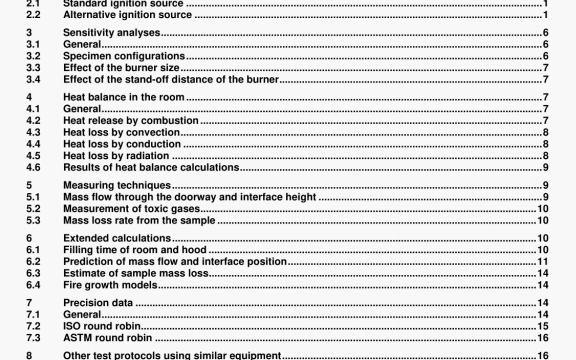ISO/TR 09705-2 pdf download – Reaction-to-fire tests -Full-scale roomtests for surface products — Part 2: Technical background and guidance.
5.2 Measurement of toxic gases
Additional to the measurement techniques given ISO 9705, techniques such as FTIR and ion chromatography have recently been applied successfully in full-scale tests A practical example how this can be perlomied is given in annex 8. The reader is also referred to the documents developed within lSO/TC 92/SC 3 f a complete overview of the measurement of toxic gases wi combustion gases produced in lire tests.
5.3 Mass loss rate from the sample
Direct mass loss measurements of the Nnings can be performed by means of putting the complete room on load cells or by putting the structure on which the linings are fixed on load cells. Due to the high tare value obtained by the weight of the room, it should be noted that only limited accuracy can be obtained. For items positioned in the room, a weighing platform as used in furniture calorimeters can be used and has been successfuly applied.
6 Extended calculations
6.1 Filling time of room and hood
At the beginning of a test there is some delay time in order to fill the part above the sort it level of the door in the room. Filing of the hood in the beginning of the test is almost negligible since the smoke gases will enter immediately into the cct. Some filling of the hood might occur later on in the test if the extraction rate ‘S close to the limit at the system. This is close to flashover conditions If the maximum exhaust flow rate is used. Delay time correction can be easily incorporated into the time shifting of the data.
Thus, the net rate of heat release by me specimen follows from subtracting E(m02 ) from q calculated acoording to equation (A.11), (A.20) or (k32).
Although this procedure is straightforward, there is a problem in practicaJ applications. The problem is related to the delay in response of the instrumentation in the exhaust duct. The delay consists partly of the time required by the combustion products to travel from the two to the measunng point. This transport time can easily be taken into account by shifting the measurements over the appropriate transport time interval. However, a considerable part of the delay is usually much more difficult to Correct and is due to filling of an enclosure, response time of gas analysers etc.
bi cases where the latter part of the delay turns out to be significant, a better procedure to determine q, may consist of running a caIwahon test with the ignition source and a non-combustible specimen. Such a test yields a baseline rate of heat release curve. For subsequent tests, q is determined by subtracting the baseline from the HRR obtained via (All), (A.20) or (A.32). The same procedure may be used for ignition sources with unknown heat of combustion or unknown combustion efficiency, such as wood crs.
A.3 Summary at calculation procedures
Depending on the configuration of gas analysers and the type of flow rate measiiemerit. clferent procedures shoiid be used to caJculate the rate of heat release With the most common Instrumentation the recommended procedure consists of the following steps.
B.1 Description of the FTIR measurement technique
A complete description of the testing method is given in NT FIRE 047 (42). The principle of this method can be explained as follows.
Smoke gas samples for the FTIR analysis are taken from a gas samphog line connected to the test paratus (usuety the exhaust duct). The gas sample is drawn continuously through a heated sampling line to a heated IR absorption cel of a FTIR spectrometer. The infrared beam is directed from the interferometer through the gas absorption cell, at chosen intervals. interlerograms are acquired arid after the test converted to absorption spectra.
The sampling line and the IR absorption Cd are heated to keep the smoke gas composition unchanged for the analysis. At the elevated temperature of over 120°C water prevented from liquefying, gases soluble in water [e.g. hydrogen cyanide (HCN) and hydrogen chloride (HCI), etc.) from dissolving and lightwelght gases insoluble in water from precipitating.
ISO/TR 09705-2 pdf download – Reaction-to-fire tests -Full-scale roomtests for surface products — Part 2: Technical background and guidance
